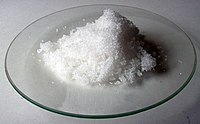
Photo from wikipedia
This work presents the characteristics of a solar thermal tower power plant in two different places (Seville and Dubai) using three different HTFs (NaNO3-KNO3, KCl-MgCl2 and Li2CO3-Na2CO3-K2CO3) and three different… Click to show full abstract
This work presents the characteristics of a solar thermal tower power plant in two different places (Seville and Dubai) using three different HTFs (NaNO3-KNO3, KCl-MgCl2 and Li2CO3-Na2CO3-K2CO3) and three different power cycles (Rankine, sCO2 Recompression and sCO2 Partial cooling cycles). An indirect configuration is considered for the Gemasolar power plant. Detailed modelling is carried out for the conversion of incident power on the heliostat to the output electricity. Optimization of the cycle is carried out to determine the most promising cycle configuration for efficiency. The results showed that for the Gemasolar power plant configuration, the performance of the KCl-MgCl2 based plant was poorest amongst all. NaNO3-KNO3 based plant has shown good performance with the Rankine cycle but plant having Li2CO3-Na2CO3-K2CO3 as HTF was best for all three cycles. Partial cooling was the best performing cycle at both locations with all three HTFs. Placing the Seville Plant in Dubai has improved the efficiency from 23.56% to 24.33%, a capacity factor improvement of 21 and 52 GW additional power is generated. The optimization of the plant in Dubai has shown further improvements. The efficiency is improved, the Capacity factor is increased by 31.2 and 77.8 GW of additional electricity is produced.
Journal Title: Advances in Mechanical Engineering
Year Published: 2021
Link to full text (if available)
Share on Social Media: Sign Up to like & get
recommendations!